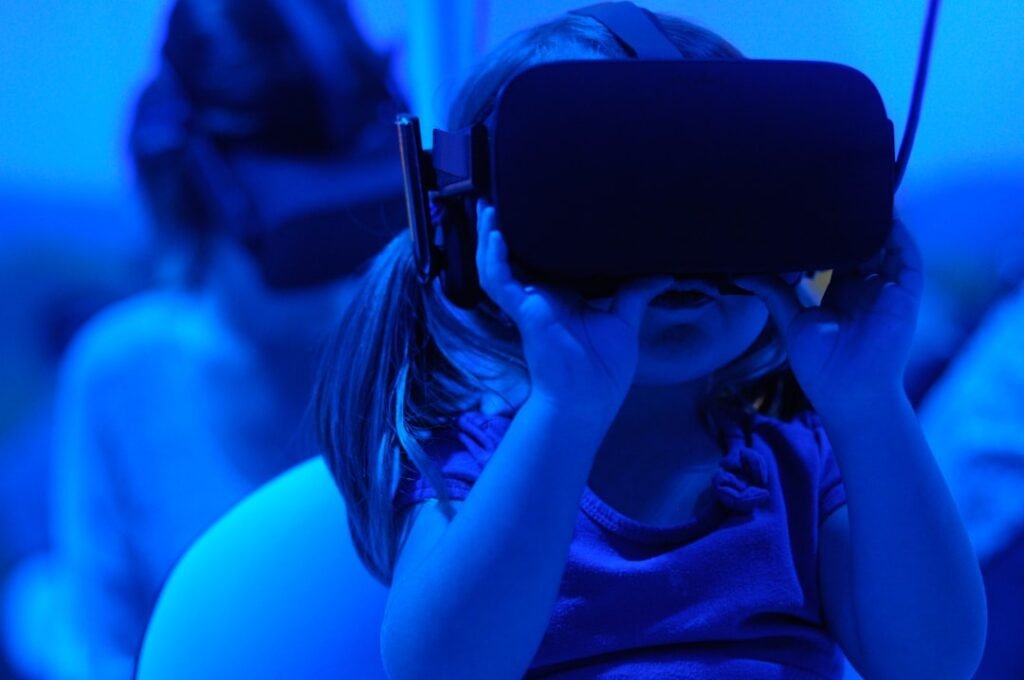Now Reading: The Future of Augmented Reality Gaming: Pokemon GO and Beyond
-
01
The Future of Augmented Reality Gaming: Pokemon GO and Beyond
The Future of Augmented Reality Gaming: Pokemon GO and Beyond

As I delve into the world of augmented reality (AR) gaming, I find myself captivated by the seamless blend of digital elements with the physical environment. Augmented reality has transformed the way I perceive and interact with games, creating immersive experiences that extend beyond traditional gaming boundaries. Unlike virtual reality, which transports me to entirely different worlds, AR enhances my real-world surroundings by overlaying digital content.
This innovative technology has opened up a realm of possibilities, allowing me to engage with games in ways I never thought possible. The allure of AR gaming lies in its ability to create a unique interaction between the player and their environment. I can step outside my front door and embark on a quest that integrates my local park or neighborhood into the gameplay.
This fusion of reality and digital elements not only enriches my gaming experience but also encourages me to explore my surroundings. As I navigate through this exciting landscape, I am constantly reminded of how AR gaming is reshaping the industry and redefining what it means to play.
Key Takeaways
- Augmented reality gaming combines virtual elements with the real world, creating an immersive experience for players.
- Pokemon GO revolutionized the gaming industry by popularizing augmented reality gaming and introducing new possibilities for interactive gameplay.
- The evolution of augmented reality technology has led to more advanced and realistic gaming experiences, with improved graphics and interactive features.
- Augmented reality has the potential to expand beyond Pokemon GO, offering new gaming experiences in various genres and industries.
- While augmented reality gaming presents challenges such as privacy concerns, it also offers opportunities for social interaction and integration with other technologies.
The Impact of Pokemon GO on the Gaming Industry
The Impact of Augmented Reality on Gaming
Pokémon GO: A Game-Changer in AR Gaming
When I think about the impact of augmented reality on gaming, one title stands out above the rest: Pokémon GO. Released in 2016, this groundbreaking game took the world by storm, captivating millions of players, including myself. The game’s success was not merely due to its nostalgic appeal but also its innovative use of AR technology.
Transforming Everyday Locations into Vibrant Playgrounds
As I wandered through my city, searching for Pokémon, I felt a sense of adventure that transcended the screen. Pokémon GO demonstrated how AR could transform everyday locations into vibrant playgrounds filled with digital creatures waiting to be discovered.
Inspiring a New Era in Gaming
It sparked a wave of interest in AR gaming, inspiring developers to explore new possibilities within this medium. I witnessed a surge in similar games that sought to replicate its success, each attempting to capture the magic of blending the real world with digital experiences. The game’s popularity also highlighted the potential for location-based gaming, encouraging developers to create experiences that encourage players to venture outdoors and engage with their communities.
The Evolution of Augmented Reality Technology

As I reflect on the evolution of augmented reality technology, I am struck by how far we have come in such a short time. Initially, AR was a concept relegated to science fiction and experimental projects. However, advancements in smartphone technology and computer vision have propelled AR into the mainstream.
I remember when the first AR applications began to emerge, often clunky and limited in scope. Yet, as technology progressed, so did the sophistication of AR experiences. Today, I can access high-quality AR applications that seamlessly integrate with my daily life.
The development of AR glasses and headsets has further accelerated this evolution. These devices promise to enhance my experience by providing hands-free access to digital content while allowing me to remain aware of my surroundings. As I envision a future where AR is embedded in everyday life, I am excited about the potential for more immersive and interactive gaming experiences.
The continuous improvement in hardware and software capabilities suggests that we are only scratching the surface of what augmented reality can achieve in gaming.
The Potential for Augmented Reality in Gaming Beyond Pokemon GO
While Pokémon GO has undoubtedly set a high bar for augmented reality gaming, I believe there is immense potential for innovation beyond this iconic title. The versatility of AR technology allows for a wide range of gaming experiences that can cater to various interests and demographics. For instance, I can imagine educational games that utilize AR to teach history or science by bringing historical figures or scientific concepts to life right before my eyes.
This could transform learning into an engaging adventure rather than a mundane task. Moreover, AR has the potential to revolutionize multiplayer gaming experiences. Imagine collaborating with friends in real-time as we navigate through a shared augmented environment, solving puzzles or competing in challenges that blend our physical locations with digital elements.
This could foster deeper connections and create memorable shared experiences that transcend traditional gaming formats. As I consider these possibilities, I am filled with anticipation for what lies ahead in the realm of augmented reality gaming.
Challenges and Opportunities in Augmented Reality Gaming
Despite the exciting prospects of augmented reality gaming, I recognize that there are significant challenges that developers must navigate. One major hurdle is ensuring that AR experiences are accessible and user-friendly for a broad audience. As someone who enjoys exploring new technologies, I understand that not everyone is as tech-savvy or willing to adapt to new interfaces.
Developers must prioritize intuitive design and seamless integration into everyday life to ensure that AR gaming reaches its full potential. Additionally, there are technical challenges related to hardware limitations and environmental factors. For instance, not all smartphones are equipped with the necessary sensors or processing power to deliver high-quality AR experiences.
As I think about these obstacles, I also see opportunities for innovation. Companies can invest in research and development to create more powerful devices or explore alternative platforms for AR gaming, such as smart glasses or wearables. By addressing these challenges head-on, developers can unlock new avenues for growth within the augmented reality gaming landscape.
The Role of Augmented Reality in Social Interaction

One of the most compelling aspects of augmented reality gaming is its potential to enhance social interaction among players. As I engage with AR games, I often find myself connecting with others who share similar interests and passions. Whether it’s teaming up with friends to catch Pokémon or competing against strangers in an AR scavenger hunt, these experiences foster a sense of community that transcends geographical boundaries.
Moreover, AR gaming encourages players to step outside their homes and engage with their surroundings and each other. This shift from solitary gameplay to social interaction is refreshing and invigorating. I appreciate how AR games can bring people together, creating shared memories and experiences that strengthen relationships.
As I reflect on my own experiences with AR gaming, I am reminded of the power it has to forge connections and build communities around shared interests.
The Integration of Augmented Reality with Other Technologies
As I explore the future of augmented reality gaming, I am excited about the potential for integration with other emerging technologies. For instance, combining AR with artificial intelligence (AI) could lead to more personalized and adaptive gaming experiences. Imagine an AR game that learns from my preferences and behaviors, tailoring challenges and quests specifically for me.
This level of customization could enhance engagement and keep me coming back for more. Additionally, integrating AR with virtual reality (VR) could create hybrid experiences that offer the best of both worlds. While VR immerses me in entirely different environments, combining it with AR elements could allow me to interact with my physical surroundings while still being enveloped in a virtual world.
This fusion could lead to groundbreaking gameplay mechanics and storytelling opportunities that push the boundaries of what we consider gaming today.
The Future of Augmented Reality Gaming in Education and Training
Beyond entertainment, I see immense potential for augmented reality gaming in education and training contexts. As someone who values lifelong learning, I am particularly excited about how AR can transform traditional educational methods into engaging experiences. Imagine being able to explore ancient civilizations through an interactive AR game that allows me to walk through historical sites while learning about their significance in real-time.
In professional training scenarios, AR can provide hands-on experience without the risks associated with real-world practice. For instance, medical students could use AR simulations to practice surgical techniques or emergency response scenarios in a safe environment. This application not only enhances learning but also builds confidence as individuals prepare for real-life situations.
As I envision these possibilities, I am optimistic about how augmented reality can revolutionize education and training across various fields.
Ethical and Privacy Considerations in Augmented Reality Gaming
As augmented reality gaming continues to evolve, it is crucial for me to consider the ethical implications and privacy concerns associated with this technology. With location-based games like Pokémon GO, players often share their whereabouts while engaging in gameplay. This raises questions about data privacy and security as developers collect vast amounts of user data to enhance their experiences.
Moreover, there is a risk of overexposure to digital content in our physical environments. As someone who values balance in life, I recognize the importance of setting boundaries when it comes to technology use. Developers must prioritize ethical practices by ensuring transparency regarding data collection and usage while also promoting responsible gameplay habits among users.
By addressing these concerns proactively, we can create a safer and more enjoyable environment for all players.
The Business Opportunities in Augmented Reality Gaming
The rise of augmented reality gaming presents numerous business opportunities for entrepreneurs and established companies alike. As I observe the growing interest in this sector, it becomes clear that there is significant potential for innovation and revenue generation. From developing new AR games to creating accessories like smart glasses or wearables, businesses can tap into this burgeoning market by offering unique products and services.
Additionally, partnerships between game developers and brands can lead to exciting marketing opportunities within augmented reality experiences. For instance, incorporating branded content into AR games can create engaging advertising campaigns that resonate with players while enhancing their gameplay experience. As I consider these possibilities, it becomes evident that augmented reality gaming is not just a trend; it represents a transformative shift in how we approach entertainment and commerce.
The Exciting Potential of Augmented Reality Gaming
In conclusion, my journey through the world of augmented reality gaming has revealed its exciting potential to reshape how we play, learn, and connect with one another. From the groundbreaking success of Pokémon GO to the myriad possibilities for future innovations, it is clear that AR technology is here to stay. As I look ahead, I am filled with anticipation for what lies beyond the horizon—new games that challenge our perceptions, educational tools that inspire curiosity, and social interactions that foster community.
While challenges remain on this path toward widespread adoption, the opportunities for growth and innovation are boundless. By embracing ethical practices and prioritizing user experience, developers can unlock new dimensions within augmented reality gaming that will captivate players for years to come. As an avid gamer and enthusiast of technology, I am excited to witness this evolution unfold before my eyes—an adventure where reality meets imagination in ways we have yet to fully explore.
If you’re a fan of augmented reality gaming like Pokemon GO, you may also enjoy exploring cozy games similar to Stardew Valley. These relaxing and immersive games offer a different kind of gaming experience that can be just as engaging as AR games. Check out this article on top cozy games similar to Stardew Valley to discover some hidden gems in the gaming world.
FAQs
What is augmented reality gaming?
Augmented reality gaming is a type of video game that combines the real world with computer-generated elements. Players use a device, such as a smartphone or AR glasses, to interact with virtual objects and characters in the real world.
What is Pokemon GO?
Pokemon GO is a popular augmented reality mobile game developed by Niantic. It allows players to capture, train, and battle virtual creatures called Pokemon, which appear in the real world using the player’s GPS and camera.
How has Pokemon GO impacted the future of augmented reality gaming?
Pokemon GO has demonstrated the potential for augmented reality gaming to engage and connect players in the real world. Its success has inspired other game developers to explore new ways to incorporate AR technology into their games.
What are some potential future developments in augmented reality gaming?
Future developments in augmented reality gaming may include more immersive gameplay experiences, improved AR technology, and the integration of AR into other gaming genres such as action, adventure, and sports.
What are the challenges and limitations of augmented reality gaming?
Challenges and limitations of augmented reality gaming include technical constraints, such as battery life and device compatibility, as well as concerns about privacy, safety, and the potential for addiction. Additionally, creating compelling and sustainable AR gaming experiences can be a significant challenge for developers.



























